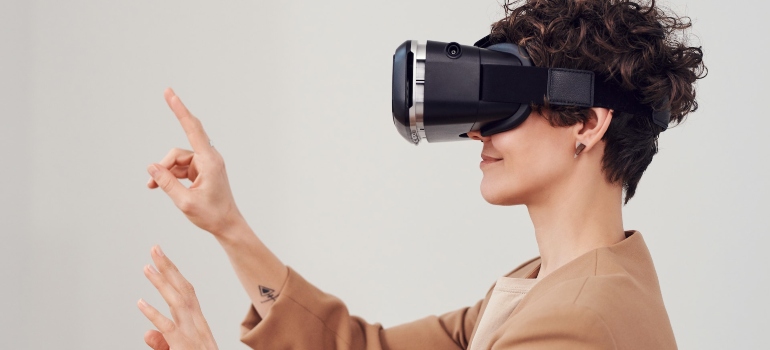Traditionally, addiction treatment has relied on talk therapy, medication, and support groups. However, with the advancement of technology, new treatment methods are being developed to help patients overcome addiction. One such method is the use of virtual reality (VR). It’s safe to say that the application of virtual reality in addiction treatment is about to revolutionize drug and alcohol rehab in West Virginia due to promising results.
What is Virtual Reality?
Virtual Reality (VR) is a computer-generated simulation of an environment or experience that can be experienced through a headset or other equipment. In VR, you can be transported to another world, explore new places, and interact with virtual objects and characters in a seemingly real and immersive way. VR technology uses a combination of computer graphics, audio, and sensory feedback to create an experience that feels real to the user. With a VR headset, you can look around and move your head to explore a virtual environment in 360 degrees. Some VR systems also use hand-held controllers or other devices to allow you to interact with virtual objects and perform actions in the virtual world.

Virtual Reality has come a long way since its inception, and it is now used in many fields, such as entertainment, education, and healthcare. The technology has evolved to the point where it can create realistic simulations of various scenarios and environments. This makes it an ideal tool for immersive training, education, and treatment in a variety of settings. With continued advancements in VR technology, the potential uses and benefits of this tool are likely to expand in the years to come.
How Can Virtual Reality Be Applied To Addiction Treatment?
Virtual reality (VR) has emerged as a promising tool for addiction treatment due to its ability to create immersive, realistic environments that can simulate situations, triggers, and cravings associated with addiction.
What is Virtual Reality Exposure Therapy
Virtual Reality Exposure Therapy (VRET) is a technique used to treat various anxiety disorders by exposing patients to anxiety-provoking stimuli in a safe and controlled environment. VRET is also useful in treating addiction as it can simulate real-life situations that trigger drug or alcohol cravings. Patients can practice coping mechanisms in a simulated environment, helping them to develop resilience against cravings and triggers.
For example, a patient with alcohol addiction can use virtual reality to practice refusing drinks in a bar, a situation that would otherwise be difficult to simulate in real life. By practicing in a controlled virtual environment, the patient can develop confidence and strategies for dealing with triggers and cravings when they occur in real life. The same applies to situations that involve drug usage. Due to this, every innovative cocaine treatment center implements VR in treatment programs.
Cognitive Behavioral Therapy Combined with Virtual Reality
Cognitive Behavioral Therapy (CBT) is a popular form of talk therapy that is effective in treating addiction. CBT helps patients identify and change negative patterns of thinking and behavior that lead to addiction. By combining Cognitive Behavioral Therapy for substance use disorders with VR, patients can learn coping skills in a more immersive and engaging way. For example, a patient with opioid addiction can use VR to simulate the effects of taking opioids, which can help them identify the negative consequences of drug use.

VR can also be used to help patients develop healthy coping mechanisms by simulating positive experiences, such as spending time with family and friends, engaging in hobbies, or enjoying nature. Patients can practice coping skills in a realistic and safe environment, which can help them develop confidence in their ability to overcome addiction. That’s why VR is applied in Benzo addiction treatment and other types of rehab.
Motivational Interviewing Combined with Virtual Reality
Another counseling technique that helps patients identify and resolve ambivalence about addiction treatment is Motivational Interviewing for substance abuse (MI). MI is particularly effective in helping patients who are not yet ready to commit to treatment. By combining MI with VR, patients can explore their motivations and goals in a more interactive and engaging way.
For example, a patient with alcohol addiction can use VR to simulate the negative consequences of continued drinking, such as health problems, financial difficulties, and strained relationships. By experiencing these consequences in a realistic way, patients can develop a greater sense of motivation to overcome their addiction.
Holistic Therapy for Addiction and VR
Holistic therapies are becoming increasingly popular in addiction treatment, and VR can be used as a complement to these therapies. This kind of therapy involves treating the whole person, including their physical, mental, and spiritual well-being. VR can be used to create immersive and relaxing environments that promote relaxation, mindfulness, and stress reduction. Patients can be exposed to calming virtual environments, such as a beach or forest while receiving guided meditation or deep breathing exercises.

Additionally, VR can be used to provide sensory experiences, such as sound therapy or aromatherapy, that can promote relaxation and stress reduction. By combining VR with holistic therapy for addiction, patients can receive a more comprehensive and personalized treatment plan that addresses their physical, mental, and spiritual needs.
The Effectiveness of VRET
The effectiveness of Virtual Reality Exposure Therapy (VRET) for addiction treatment has been studied by various institutions and researchers around the world. For instance, a study published in the Journal of Medical Internet Research found that VRET was effective in reducing alcohol cravings in patients with alcohol use disorder. The study found that patients who received VRET reported a significant reduction in their craving scores compared to those who received conventional treatment. Plus, patients were able to handle fentanyl detox treatment a lot easier thanks to the VR environment.
Another study published in the journal Cyberpsychology, Behavior, and Social Networking investigated the effectiveness of VRET for treating nicotine addiction. The study found that participants who received VRET reported a significant reduction in their nicotine cravings compared to those who received a standard cognitive-behavioral therapy (CBT) intervention. Moreover, a meta-analysis conducted by researchers at the University of Barcelona found that VRET was effective in reducing anxiety and stress in patients with substance use disorder. The analysis included 18 studies that investigated the effectiveness of VRET for addiction treatment and found that VRET was associated with significant improvements in anxiety and stress levels.
Overall, these studies suggest that VRET is a promising and effective tool for addiction treatment. VRET can help patients overcome addiction by providing a safe and controlled environment where they can practice coping skills and develop resilience against triggers and cravings. As more research is conducted, VR will likely become an increasingly important tool in the field of addiction treatment.
Different Ways Virtual Reality Is Used in Addiction Treatment
By providing a safe and controlled environment, VR can help patients overcome addiction. Below are some of the reasons why you should seek a rehab center in Marietta OH that incorporates VR into rehab programs.

Substance-Specific Cues
One of the ways VR is used in addiction treatment is by exposing patients to substance-specific cues. These cues can trigger cravings and relapse in patients with substance use disorders. VR technology can simulate these cues in a safe and controlled environment. This will allow patients to practice coping strategies and develop resilience against triggers.
Social Cues
Social cues can also trigger cravings and relapse in patients with substance use disorders. VR can simulate social settings, allowing patients to practice social skills. That can help them develop confidence in social situations without the presence of drugs or alcohol.

For example, VR can simulate a job interview or a social gathering where patients can practice social skills. They can also learn to manage social anxiety without the use of drugs or alcohol.
Coping Skills
VR can also be used to help patients practice coping skills in a safe and controlled environment. By simulating stressful situations, patients can practice relaxation techniques, mindfulness, and other coping strategies. That can help them manage stress and cravings in the real world.
For example, patients with opioid use disorder can be exposed to virtual environments that simulate pain and stress. Patients can practice relaxation techniques and coping strategies that can help them manage pain and stress without opioids.
Relapse Prevention
VR can also be used in relapse prevention by helping patients identify triggers and develop strategies to avoid them. By simulating triggers and high-risk situations, patients can practice coping strategies and develop a relapse prevention plan.
For example, patients with gambling addiction can be exposed to virtual environments that simulate a casino. In this environment, patients can practice coping strategies and develop a relapse prevention plan. This can help them avoid high-risk situations in the real world.
Aftercare Treatment
VR can also be used in aftercare treatment by providing ongoing support and monitoring. By using VR technology, patients can receive ongoing therapy and support from a remote location. For example, patients with substance use disorder can receive ongoing therapy and support through a virtual platform that simulates a therapy session. That way, it’s possible to reduce the risk of relapse and improve outcomes.
How Does Virtual Reality Help in Addiction Treatment
There are several common ways in which VR contributes to successful addiction recovery and long-term sobriety.
Enhancing Exposure Therapy
Exposure therapy is a highly effective treatment for addiction. It involves exposing patients to their triggers and cravings in a controlled environment. This helps them build resilience and learn coping strategies. VR can enhance exposure therapy by providing a more realistic and immersive experience. Patients can be exposed to a range of environments and situations that trigger their addiction. That can allow them to develop the skills and strategies needed to overcome their addiction.
Personalized and Tailored Treatment
Every patient’s journey to recovery is unique, and VR can help tailor treatment to each patient’s individual needs. VR can be used to create personalized and tailored treatment plans based on a patient’s specific triggers and cravings. For example, a patient with alcohol use disorder can be exposed to virtual environments that simulate a bar or social setting where alcohol is present. Conversely, a patient with opioid use disorder can be exposed to virtual environments that simulate pain and stress.

Additionally, VR can be used to track a patient’s progress and adjust treatment plans accordingly. By analyzing a patient’s performance in virtual environments, therapists can gain insights into their progress. They can also tailor treatment to their specific needs. This is why the best option would be a rehab center in Huntington WV that utilizes VR for customizing unique treatment plans.
Safe Environment for Practice
Addiction treatment often involves patients practicing coping strategies and relapse prevention techniques. VR provides a safe and controlled environment for patients to practice these skills without the risk of relapse. Patients can practice saying no to drugs or alcohol, managing cravings, and developing coping strategies. At the same time, they will experience no fear of judgment or negative consequences.
Increasing Motivation and Engagement
One of the biggest challenges in addiction treatment is keeping patients engaged and motivated. VR offers a highly engaging and immersive experience that can help patients stay motivated throughout their treatment. Patients can explore different environments and situations, interact with virtual avatars, and receive immediate feedback and reinforcement. That makes the treatment process more enjoyable and rewarding.
Virtual Reality in Addiction Treatment Shows Potential
The application of Virtual Reality in addiction treatment is still in its initial stages. However, the results so far have shown a myriad of benefits that open the door to many possibilities. With the help of VR, patients can confront and overcome triggers and urges in a safe and controlled environment. Additionally, clinicians can use VR as a tool to tailor treatment to individual needs and monitor patient progress. As technology continues to evolve and improve, virtual reality has the potential to revolutionize addiction treatment.



